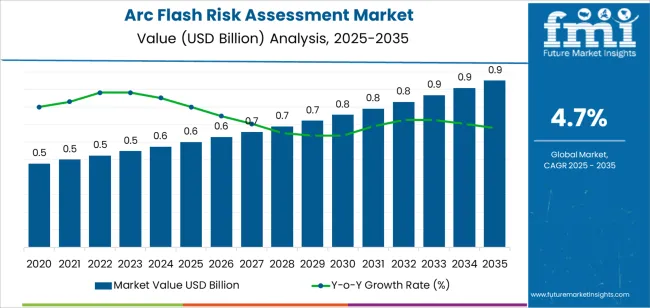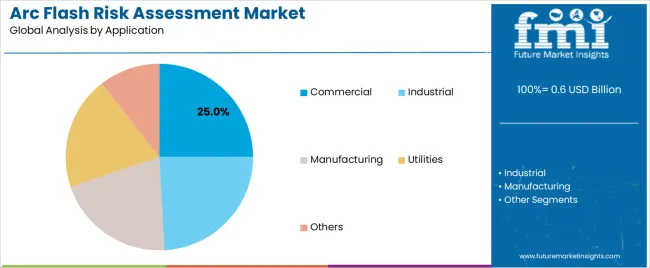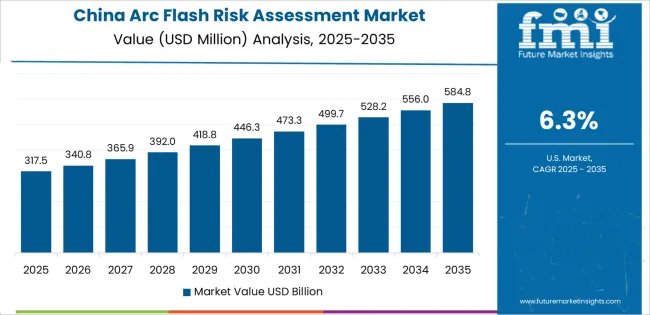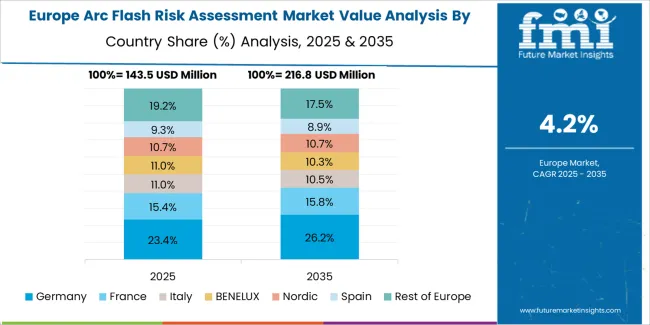The global arc flash risk assessment market is valued at USD 0.6 billion in 2025. It is slated to reach USD 1 billion by 2035, recording an absolute increase of USD 379.6 million over the forecast period. This translates into a total growth of 58.3%, with the market forecast to expand at a compound annual growth rate (CAGR) of 4.7% between 2025 and 2035. The overall market size is expected to grow by nearly 1.58X during the same period, supported by increasing electrical safety regulations and workplace safety requirements, growing adoption of predictive maintenance programs in industrial facilities, and rising emphasis on worker protection and electrical hazard mitigation across diverse manufacturing plants, utility operations, and commercial building management applications.
Between 2025 and 2030, the arc flash risk assessment market is projected to expand from USD 0.6 billion to USD 782.4 million, resulting in a value increase of USD 131.3 million, which represents 34.6% of the total forecast growth for the decade. This phase of development will be shaped by increasing regulatory enforcement of electrical safety standards requiring documented arc flash studies, rising adoption of comprehensive electrical safety programs, and growing demand for third-party arc flash assessment services in existing facilities. Industrial facility managers and electrical safety professionals are expanding their arc flash risk assessment capabilities to address the growing demand for compliant electrical safety documentation and worker protection solutions that ensure regulatory compliance and operational safety.

From 2030 to 2035, the market is forecast to grow from USD 782.4 million to USD 1 billion, adding another USD 248.3 million, which constitutes 65.4% of the overall ten-year expansion. This period is expected to be characterized by the expansion of digital twin technologies for virtual arc flash modeling and simulation, the development of artificial intelligence-driven predictive hazard assessment platforms, and the growth of specialized applications for renewable energy installations and electric vehicle charging infrastructure. The growing adoption of cloud-based electrical safety management systems and remote assessment technologies will drive demand for integrated arc flash risk assessment solutions with enhanced functionality and real-time monitoring features.
Between 2020 and 2025, the arc flash risk assessment market experienced steady growth, driven by increasing workplace safety awareness and growing recognition of arc flash hazards as critical safety concerns requiring systematic risk evaluation and mitigation in diverse industrial, commercial, and utility electrical systems. The market developed as safety managers and electrical engineers recognized the potential for comprehensive arc flash studies to prevent severe injuries, ensure regulatory compliance, and support proactive electrical safety management while meeting occupational health and safety requirements. Technological advancement in arc flash calculation software and incident energy analysis began emphasizing the critical importance of maintaining accurate electrical system modeling and protective device coordination in complex power distribution environments.
| Metric | Value |
|---|---|
| Estimated Value in (2025E) | USD 0.6 billion |
| Forecast Value in (2035F) | USD 1 billion |
| Forecast CAGR (2025 to 2035) | 4.7% |
Market expansion is being supported by the increasing global emphasis on workplace electrical safety driven by regulatory requirements and liability concerns, alongside the corresponding need for comprehensive hazard assessment services that can identify arc flash risks, calculate incident energy levels, and implement protective measures across various industrial electrical systems, commercial power distribution networks, and utility infrastructure applications. Modern facility managers and safety directors are increasingly focused on implementing arc flash risk assessment programs that can prevent electrical injuries, ensure compliance with safety standards, and provide documented protection strategies in demanding operational environments.
The growing emphasis on occupational safety regulations and electrical safety standard compliance is driving demand for arc flash risk assessments that can support comprehensive electrical safety programs, enable proper personal protective equipment selection, and ensure worker protection through accurate hazard labeling and safe work procedures. Industrial operators' preference for professional assessment services that combine technical expertise with regulatory knowledge and practical safety recommendations is creating opportunities for innovative arc flash assessment implementations. The rising influence of predictive maintenance strategies and electrical system modernization programs is also contributing to increased adoption of arc flash studies that can provide detailed system analysis without compromising operational continuity or facility productivity.
The market is segmented by assessment type, application, and region. By assessment type, the market is divided into engineering-based assessment, incident investigation-based assessment, PPE category-based assessment, and others. Based on application, the market is categorized into commercial, industrial, manufacturing, utilities, and others. Regionally, the market is divided into East Asia, Europe, North America, South Asia, Latin America, Middle East & Africa, and Eastern Europe.

The engineering-based assessment segment is projected to maintain its leading position with 35% market share in the arc flash risk assessment market in 2025, reaffirming its role as the preferred assessment approach for comprehensive electrical safety analysis and regulatory compliance documentation. Electrical engineers and safety professionals increasingly utilize engineering-based arc flash assessments for their detailed analysis capabilities, proven accuracy in incident energy calculations, and ability to provide specific protective recommendations while supporting system-wide electrical safety improvements. Engineering-based assessment methodology's proven effectiveness and technical rigor directly address the industry requirements for compliant electrical safety programs and comprehensive hazard mitigation across diverse facility types and electrical system configurations.
This assessment type segment forms the foundation of modern electrical safety management programs, as it represents the methodology with the greatest contribution to accurate hazard identification and established credibility record across multiple industrial sectors and regulatory jurisdictions. Industrial sector investments in workplace safety infrastructure continue to strengthen adoption among facility managers and electrical contractors. With regulatory agencies requiring detailed arc flash studies and documented electrical safety procedures, engineering-based assessments align with both compliance objectives and technical accuracy requirements, making them the central component of comprehensive electrical safety strategies.

The commercial application segment is projected to represent 25% share of arc flash risk assessment demand in 2025, underscoring its critical role as a primary driver for assessment adoption across office buildings, retail facilities, healthcare institutions, and educational campuses. Commercial facility managers prefer arc flash risk assessments for electrical safety compliance due to their essential contribution to occupant protection, liability risk reduction, and ability to ensure safe electrical maintenance operations while supporting building code compliance and insurance requirements. Positioned as essential services for modern commercial property management, arc flash risk assessments offer both safety advantages and regulatory compliance support.
The segment is supported by continuous evolution in building electrical safety codes and the growing availability of specialized assessment providers that enable efficient evaluation with minimal disruption and comprehensive safety documentation. Additionally, commercial property owners are investing in periodic arc flash assessment programs to support increasingly stringent insurance requirements and facility management demand for documented electrical safety procedures and worker protection protocols. As commercial building complexity increases and electrical safety awareness grows, the commercial application will continue to drive significant market activity while supporting proactive electrical safety management and assessment service utilization strategies.
The arc flash risk assessment market is advancing steadily due to increasing regulatory enforcement of electrical safety standards driven by workplace injury prevention initiatives and growing adoption of comprehensive electrical safety programs that provide effective hazard identification and worker protection benefits across diverse industrial facilities, commercial buildings, and utility infrastructure applications. However, the market faces challenges, including cost considerations and budget constraints for small and medium enterprises, technical complexity requiring specialized electrical engineering expertise, and assessment frequency requirements related to electrical system modifications and regulatory update cycles. Innovation in digital assessment tools and automated calculation methods continues to influence service delivery and market expansion patterns.
The growing enforcement of electrical safety standards including NFPA 70E, IEEE 1584, and international equivalents is driving demand for professional arc flash assessment services that address mandatory compliance requirements including incident energy calculations, equipment labeling, and safe work procedure development. Industrial electrical safety compliance requires comprehensive engineering analysis that evaluates fault current levels, protective device coordination, and worker exposure scenarios across complex electrical distribution systems. Facility managers are increasingly recognizing the liability protection and worker safety benefits of documented arc flash studies conducted by qualified professionals, creating opportunities for specialized assessment services specifically designed for industrial facilities and high-risk electrical environments.
Modern arc flash risk assessment service providers are incorporating digital modeling software and cloud-based safety management platforms to enhance assessment accuracy, enable real-time safety documentation access, and support comprehensive electrical safety program management through digital electrical system models, automated label generation, and centralized safety procedure distribution. Leading companies are developing integrated platforms with three-dimensional facility modeling, automated calculation updates, and mobile access capabilities that allow safety managers to maintain current electrical safety documentation and coordinate electrical work permits remotely. These technologies improve safety program effectiveness while enabling new service delivery models, including subscription-based assessment updates, remote technical support, and data-driven safety performance monitoring. Advanced technology integration also allows service providers to differentiate offerings and address facility management requirements beyond traditional assessment documentation.
The expansion of predictive maintenance programs and increasing availability of electrical system monitoring technologies is driving development of continuous arc flash risk monitoring solutions with real-time hazard assessment capabilities. These advanced applications require integration of electrical parameter monitoring and automated calculation engines that enable dynamic hazard level updates as electrical system conditions change, creating premium market segments with differentiated value propositions. Service providers are investing in sensor integration technologies and advanced analytics platforms to serve facilities requiring continuous electrical safety monitoring and automated compliance documentation while supporting innovation in predictive electrical safety management and real-time worker protection strategies.

| Country | CAGR (2025-2035) |
|---|---|
| China | 6.3% |
| India | 5.9% |
| Germany | 5.4% |
| Brazil | 4.9% |
| USA | 4.5% |
| UK | 4.0% |
| Japan | 3.5% |
The arc flash risk assessment market is experiencing solid growth globally, with China leading at 6.3% CAGR through 2035, driven by expanding industrial capacity, growing workplace safety enforcement, and increasing adoption of international electrical safety standards. India follows at 5.9%, supported by manufacturing sector growth, industrial safety regulation development, and rising multinational corporation electrical safety requirements. Germany shows growth at 5.4%, emphasizing advanced electrical safety engineering, comprehensive workplace protection frameworks, and strong industrial facility management practices.
Brazil demonstrates 4.9% growth, supported by industrial expansion, growing safety regulation enforcement, and increasing foreign investment driving international safety standard adoption. The United States records 4.5%, focusing on NFPA 70E compliance, industrial facility modernization, and comprehensive electrical safety program development. The United Kingdom exhibits 4.0% growth, emphasizing electrical safety regulation enforcement and facility management best practices. Japan shows 3.5% growth, supported by established industrial safety culture and electrical system maintenance excellence.
The report covers an in-depth analysis of 40+ countries top-performing countries are highlighted below.

Revenue from arc flash risk assessment services in China is projected to exhibit exceptional growth with a CAGR of 6.3% through 2035, driven by expanding industrial manufacturing capacity and rapidly growing workplace safety regulation enforcement supported by government Work Safety Law implementation and industrial safety standard enhancement programs. The country's massive industrial infrastructure and increasing emphasis on worker protection are creating substantial demand for arc flash risk assessment solutions. Major electrical safety service providers and international engineering firms are establishing comprehensive service delivery capabilities to serve both domestic markets and regional industrial facilities.
Revenue from arc flash risk assessment services in India is expanding at a CAGR of 5.9%, supported by the country's rapidly growing manufacturing sector under Make in India initiatives, expanding industrial infrastructure, and increasing regulatory emphasis on workplace electrical safety. The country's industrial expansion and improving safety awareness are driving sophisticated arc flash assessment capabilities throughout manufacturing and industrial facilities. Leading electrical engineering firms are establishing service capabilities and technical expertise to address growing demand.
Revenue from arc flash risk assessment services in Germany is expanding at a CAGR of 5.4%, supported by the country's world-class electrical engineering expertise, comprehensive workplace safety regulations, and strong emphasis on technical precision in hazard assessment. The nation's industrial excellence and safety culture are driving sophisticated arc flash assessment capabilities throughout manufacturing and industrial sectors. Leading engineering consulting firms are investing extensively in advanced assessment methodologies and technical training for German market requirements.
Revenue from arc flash risk assessment services in Brazil is expanding at a CAGR of 4.9%, supported by the country's growing industrial sector, increasing workplace safety regulation enforcement through NR-10 requirements, and expanding multinational corporation operations driving international safety standard adoption. Brazil's industrial modernization and safety awareness development are driving demand for professional electrical safety services. Engineering consulting firms are investing in market development to serve both multinational corporations and domestic industrial operators.
Revenue from arc flash risk assessment services in the United States is expanding at a CAGR of 4.5%, supported by the country's comprehensive electrical safety standards under NFPA 70E, extensive industrial infrastructure requiring periodic assessment updates, and growing emphasis on electrical worker protection and liability risk management. The nation's established electrical safety framework and professional engineering community are driving demand for qualified arc flash assessment services. Engineering firms are investing in advanced assessment technologies and technical expertise to support evolving standard requirements and client needs.
Revenue from arc flash risk assessment services in the United Kingdom is expanding at a CAGR of 4.0%, supported by the country's electrical safety regulations under Electricity at Work Regulations, facility management best practices, and increasing emphasis on documented electrical safety procedures. The UK's structured regulatory framework and professional engineering standards are driving systematic adoption of arc flash assessment services. Engineering consulting firms are establishing specialized electrical safety service capabilities to support commercial and industrial facility requirements.
Revenue from arc flash risk assessment services in Japan is expanding at a CAGR of 3.5%, supported by the country's established industrial safety culture, comprehensive electrical installation standards, and systematic preventive maintenance approaches. Japan's safety excellence and technical precision are driving demand for detailed electrical safety assessments. Engineering consulting firms are investing in advanced assessment capabilities for Japanese industrial requirements and safety expectations.

The arc flash risk assessment market in Europe is projected to grow from USD 195.3 million in 2025 to USD 309.2 million by 2035, registering a CAGR of 4.7% over the forecast period. Germany is expected to maintain leadership with a 27.8% market share in 2025, moderating to 27.5% by 2035, supported by advanced electrical safety engineering excellence, comprehensive workplace protection regulations, and strong industrial facility management infrastructure.
France follows with 19.4% in 2025, projected at 19.6% by 2035, driven by industrial electrical safety requirements, workplace protection regulation enforcement, and engineering consulting sector development. The United Kingdom holds 17.1% in 2025, reaching 16.8% by 2035 on the back of Electricity at Work Regulations compliance and facility management standards. Italy commands 14.3% in 2025, rising slightly to 14.5% by 2035, while Spain accounts for 9.6% in 2025, reaching 9.8% by 2035 aided by industrial safety modernization and regulatory development.
The Netherlands maintains 5.2% in 2025, up to 5.3% by 2035 due to advanced facility management practices and industrial safety emphasis. The Rest of Europe region, including Nordics, Central & Eastern Europe, and other markets, is anticipated to hold 6.6% in 2025 and 6.5% by 2035, reflecting steady development in workplace electrical safety enhancement and industrial compliance infrastructure.

The arc flash risk assessment market is characterized by competition among specialized electrical safety consulting firms, engineering service providers, and comprehensive facility management companies. Companies are investing in advanced calculation software development, technical expertise enhancement, service delivery efficiency, and client education programs to deliver accurate, compliant, and actionable arc flash risk assessment solutions. Innovation in digital modeling technologies, cloud-based safety management platforms, and automated assessment update systems is central to strengthening market position and competitive advantage.
TÜV SÜD leads the market with comprehensive technical inspection and certification services, offering arc flash risk assessment solutions with focus on technical accuracy, regulatory compliance, and international standard expertise across diverse industrial and commercial applications. Safe Arc Solutions provides specialized electrical safety services with emphasis on engineering-based assessment methodologies and practical safety recommendations. Electrical Safety UK delivers focused arc flash assessment services for British industrial and commercial markets.
Premium Power offers electrical system assessment and power quality services with integrated arc flash evaluation capabilities. Engineering Power Solutions focuses on electrical engineering consulting with comprehensive arc flash study expertise. Inspec Systems specializes in electrical testing and commissioning services including arc flash assessment.
Arc Flash Protection provides dedicated arc flash risk assessment and mitigation services. Eaton offers integrated electrical equipment and safety solutions with arc flash assessment support. DNV delivers comprehensive safety and risk management services across multiple industries. Martin Technical specializes in electrical safety consulting and arc flash studies.
Allied Reliability provides reliability engineering services including electrical system assessment. CBS Field Services offers electrical testing and commissioning with arc flash evaluation. Elliot Engineering focuses on electrical engineering consulting services. The EI Group provides integrated engineering solutions including electrical safety assessment. Mitchell & Lindsey specializes in electrical power system studies.
Arc Flash Pro offers dedicated arc flash assessment software and services. SEAM provides electrical safety and arc flash consulting. Electrical Reliability Services specializes in power system reliability and safety studies. Tesco Controls focuses on industrial control system integration with electrical safety services. Sievert Electric offers electrical contracting with safety assessment capabilities.
AMG Custom Controls provides industrial electrical services including arc flash studies. Enviros specializes in environmental and technical consulting. Quartzelec offers electrical machinery services with safety assessment integration. Omazaki focuses on electrical system design and assessment. VB Engineering provides electrical engineering consulting services. Clark Dietz offers comprehensive engineering services including electrical safety assessment.
| Items | Values |
|---|---|
| Quantitative Units (2025) | USD 0.6 billion |
| Assessment Type | Engineering-Based Assessment, Incident Investigation-Based Assessment, PPE Category-Based Assessment, Others |
| Application | Commercial, Industrial, Manufacturing, Utilities, Others |
| Regions Covered | East Asia, Europe, North America, South Asia, Latin America, Middle East & Africa, Eastern Europe |
| Countries Covered | China, India, Germany, Brazil, United States, United Kingdom, Japan, and 40+ countries |
| Key Companies Profiled | TÜV SÜD, Safe Arc Solutions, Electrical Safety UK, Premium Power, Engineering Power Solutions, Inspec Systems |
| Additional Attributes | Dollar sales by assessment type and application category, regional demand trends, competitive landscape, technological advancements in arc flash calculation, digital modeling development, cloud-based safety management integration, and electrical hazard mitigation optimization |
The global arc flash risk assessment market is estimated to be valued at USD 0.6 billion in 2025.
The market size for the arc flash risk assessment market is projected to reach USD 0.9 billion by 2035.
The arc flash risk assessment market is expected to grow at a 4.7% CAGR between 2025 and 2035.
The key product types in arc flash risk assessment market are engineering-based assessment, incident investigation-based assessment, ppe category-based assessment and others.
In terms of application, commercial segment to command 25.0% share in the arc flash risk assessment market in 2025.






Full Research Suite comprises of:
Market outlook & trends analysis
Interviews & case studies
Strategic recommendations
Vendor profiles & capabilities analysis
5-year forecasts
8 regions and 60+ country-level data splits
Market segment data splits
12 months of continuous data updates
DELIVERED AS:
PDF EXCEL ONLINE
Arch Top Casement Window Market Size and Share Forecast Outlook 2025 to 2035
Arch Top Door Market Size and Share Forecast Outlook 2025 to 2035
Architectural Metal Coating Market Forecast Outlook 2025 to 2035
Architectural Membranes Market Size and Share Forecast Outlook 2025 to 2035
Architectural Flat Glass Market Size and Share Forecast Outlook 2025 to 2035
Arc-based Plasma Lighting Market Size and Share Forecast Outlook 2025 to 2035
Arc Fault Detection Devices Market Size and Share Forecast Outlook 2025 to 2035
Arc Ferrite Magnet Market
Architectural Lighting Market
Barcode Scanner Market Size and Share Forecast Outlook 2025 to 2035
Parcel Insulation Market Analysis - Size and Share Forecast Outlook 2025 to 2035
Parchment Paper Market Size and Share Forecast Outlook 2025 to 2035
Parcel Delivery Vehicle Market Size and Share Forecast Outlook 2025 to 2035
Narcotics Scanner Market Size and Share Forecast Outlook 2025 to 2035
Garcinia Cambogia Extract Market Analysis - Size, Share, & Forecast Outlook 2025 to 2035
Carcinoid Tumor Syndrome Management Market Forecast & Analysis for 2025 to 2035
Barcode Printers & Consumables Market Growth - Trends & Forecast 2025 to 2035
Barcode Printers Market Growth - Trends & Forecast 2025 to 2035
Narcolepsy Treatment Market Growth – Trends & Industry Forecast 2024-2034
Barcode Labeller Machine Market

Thank you!
You will receive an email from our Business Development Manager. Please be sure to check your SPAM/JUNK folder too.
Chat With
MaRIA